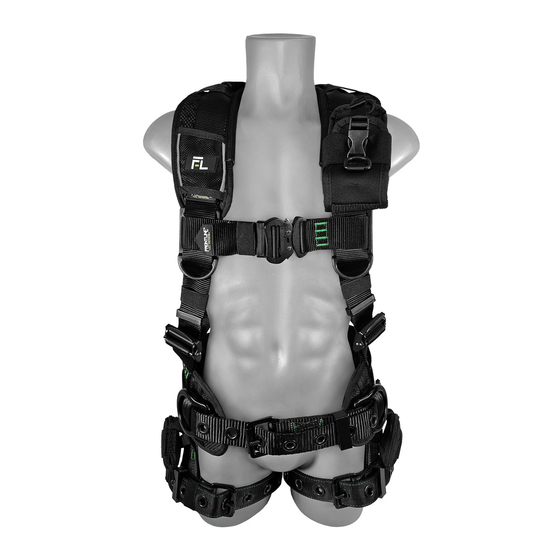
Summary of Contents for FrontLine 250CTB
- Page 1 INSTRUCTION MANUAL www.frontlinefall.com FULL BODY HARNESS 250CTB & 250VTB BUILT TO LAST MANUFACTURED TO COMPLY DESIGNED TO PROTECT Meets or exceeds applicable standards...
-
Page 2: Table Of Contents
Warning Page 3 1. Limitations for Use Page 4 2. Anchorage Requirements Page 4 3. Connection Compatibility Limitations Page 5 4. Fall Clearance/Clear Fall Charts Page 5-6 5. Donning Page 7 6. Training Page 7 7. Inspection Page 8 8. Cleaning, Maintenance and Storage Page 8 9. -
Page 3: Warning
Never use fall protection equipment for purposes other than those for which it was designed. Environmental hazards should be considered when selecting fall protection equipment. Do not expose the equipment to any hazard which it is not designed to withstand. Consult FRONTLINE in cases of doubt. -
Page 4: Limitations For Use
1.Limitations for Use This equipment is designed to be used in temperatures ranging from -40ºF to +130ºF (-40°C to +54°C). Do not expose this equipment to chemicals or harsh solutions that may have a harmful effect. Contact FRONTLINE with any questions. -
Page 5: Connection Compatibility Limitations
3.Connection Compatibility Limitations All equipment must be coupled to compatible connectors. OSHA 29 CFR 1926.502 prohibits snap hooks from being engaged to certain objects unless two requirements are met: 1. It must be a locking type snap hook. 2. It must be “designed for” making such a connection. a. - Page 6 Using an extended free fall (12 foot) Shock Absorbing Lanyard will require a total fall clearance of approximately 20 feet (6.1 meters) when anchored at foot level and measured from the anchorage point of lanyard to the nearest obstruction below. The total fall clearance combines the sum of the length of the lanyard, free fall distance, the maximum elongation of the lanyard (5 feet or 1.5 meters), the average distance between the worker’s dorsal D-ring, (5 feet or 1.5 meters), and the safety factor (3 feet or 0.9 meters).
-
Page 7: Donning
5.Donning Sewn terminations should be secure, complete, and not visibly damaged. No load indicators shall be deployed. Note: Damaged and other deteriorated and defective components must be immediately removed from service. Fitting an Full Body Harness Follow step from 1 to 7 for wearing harness. Step 1: Hold the harness by the dorsal D-ring and shake to allow any tangled straps to fall into place. -
Page 8: Inspection
7.Inspection Frequency Full Body Harnesses must be inspected prior to each use and every 6 months by a “Competent Person” other than the user. To Inspect Webbing Bend a portion of the webbing 6-8 inches into an upside-down ‘U’ shape. Continue along all webbing inspecting for tears, cuts, fraying, abrasion, discoloration, burns, holes, mold, pulled or broken stitches, or other signs of wear and damage. -
Page 9: Labeling
9.Labeling All labeling must be legible and attached to the full body harness. Where user can find the labels. -
Page 10: Annex A
10.Annex A Annex A – Normative Note: This information from the ANSI Z359.11 standard is required to be included in the instruction manual for the end user: ANSI/ASSE Z359 Requirements for Proper Use and Maintenance of Full Body Harnesses (note: these are general requirements and information provided by ANSI/ASSE Z359, the manufacturer of this equipment may impose more stringent restrictions on the use of the products they manufacture, see the manufacturer’s instructions.) 1. - Page 11 attachment is determined to be inappropriate by a competent person, and where there is no chance to fall in a direction other than feet frst. Accepted practical uses for a sternal attachment include, but are not limited to, ladder climbing with a guided type fall arrester, ladder climbing with an overhead self-retracting lifeline for fall arrest, work positioning and rope access.
-
Page 12: Checking Card
User name Inspection Record Date Reason for entry (periodic Competent person name + Comments Next Due date for examination or repair) signature periodic examination Manufacturer: Frontline Fall Protection Inc. Web: www.frontlinefall.com 2023 NW 84 Ave, Miami, Florida 33122, U.S.A. Email info@frontlinefall.com...














Need help?
Do you have a question about the 250CTB and is the answer not in the manual?
Questions and answers